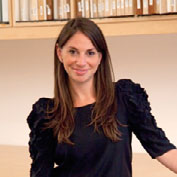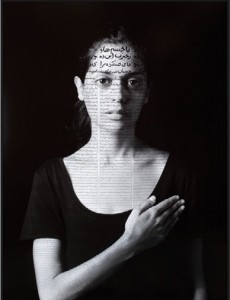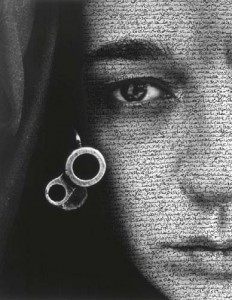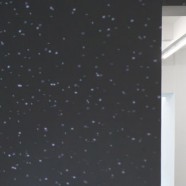
What do today’s artists and viewers make of one another?
“My work is more diplomatic than transactional,” says Molly Epstein ’00 about her role as a director for the Gladstone Gallery of New York and Brussels. The Gladstone Gallery represents a host of contemporary, internationally celebrated artists. Five of those artists know Molly as the fulcrum between ongoing artistic production and the public. “Serving as a connector and translator,” Molly says, “is a way to characterize a lot of what I do.”
Molly’s introduction to art history came during senior year at Milton in Larry Pollans’s AP Art History class. Sitting in his dark classroom with her peers looking at slides, Molly became hooked on this way of reading history through the lens of objects and visual culture. Inspired by the vast holdings of the Yale Center for British Art, her college research focused primarily on 18th- and 19th-century British art. When she graduated from Yale in 2004, Molly knew that she would work in the art world, but an actual career track wasn’t evident. Molly’s first role, manning the front desk at Sperone Westwater, a gallery associated with European and American avant-garde artists, put her in touch “with every person and organization active in the art world,” as Molly says. “You’re at an intersection of artists, dealers, critics, journalists, curators and collectors,” she says, “and the action is always fast-paced.” That dynamic environment suited Molly. After three years with Sperone Westwater, and nearly four in London, where she earned her master’s at the Courtauld Institute and worked at White Cube, the gallery that launched the careers of the Young British Artists (YBAs) such as Damien Hirst, Tracey Emin and Gary Hume, Molly returned to New York to join Gladstone Gallery.
Art-world pioneer Barbara Gladstone opened her first gallery in 1980 and has been dedicated to helping artists grow and develop their careers for more than 30 years. Molly was excited to join the team at Gladstone Gallery, helping contemporary artists realize their most effective expressions and connecting them with a diverse and growing public. “With Barbara,” Molly says, “the artists always come first.”
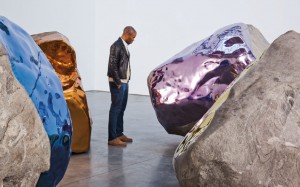
Jim Hodges, Untitled, 2011. Granite, stainless steel and lacquer. 75 x 248 x 301 inches installed. Photo credit: David Regen
A self-described advocate for her artists, Molly intensely appreciates their individual journeys. “In some galleries, you work either with artists or with collectors—private or institutional,” Molly explains. “I work with both groups. This allows me to be much more effective both in supporting individual artists and in placing their work strategically.
“Where an individual’s artistic creations are involved, the work becomes very personal. It’s about knowing where things are and where they are headed.” Looking at the whole picture, Molly’s insight is pinpointing what the artist needs next: “bringing the right attention to something at the right time.”
Her involvement with artists and their studios can be as routine as frequent phone calls to check in; or traveling to shows around the globe; or overseeing an installation—at a gallery, a museum, or for a public art project; or arranging for a lecture at a conference; or supporting a book project.
The five gallery artists Molly works with operate in different media, with distinct personal traditions and abiding themes. Understanding what exposure or support would be instrumental at any point in an artist’s creative process means being intuitive, knowledgeable and, often, bold. Mounting shows that are substantive and that register on a national and international level is a key avenue for showcasing an artist’s professional evolution.
Molly works with sculptor and installation artist Jim Hodges, and one case in point is Hodges’s 2011 exhibition of new work, mounted across both Gladstone Gallery spaces in New York. Hodges was acting chair of Yale’s sculpture department last year, and his work is featured in the permanent collections of esteemed museums across the United States and in Europe.
The two-part exhibition was Hodges’s first at the gallery’s New York locations. It showcased large-scale sculptural works that “investigate notions of time, movement, color, and reflection,” according to the gallery description. Hodges’s monumental boulders—natural surfaces facing outward and shimmering reflective surfaces facing inward—are room-size. The gallery’s interest in enabling artists to bring their ideas into being, regardless of scale or scope, figured to some degree, Molly explains, in Hodges’s execution of the work in this show. The gallery’s ability to present pieces of this size, and to welcome a broad public to experience them, allowed Hodges to take his practice in a new direction. Previously, Molly says, Hodges’s work was often characterized by an “ephemeral quality and intimate scale.”
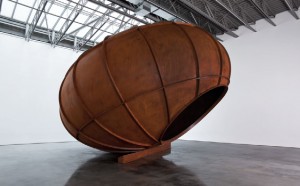
Anish Kapoor, Untitled, 2012. Weathering steel. 568 x 779 x 803 cm. Installation view: Gladstone Gallery, New York. Photo credit: David Regen
The same gallery spaces provided the appropriate environment for a groundbreaking two-part exhibition by Anish Kapoor. This exhibit incorporated a single, monumental work in Cor- ten steel at the gallery’s 21st Street location, and a collection of 22 smaller-scale, freestanding sculptures in concrete at its 24th Street location. Molly is Kapoor’s artist liaison at the gallery, and this May–June 2012 exhibit was Kapoor’s first in New York in four years. Born in Bombay, India, in 1954, Kapoor has lived and worked in London since 1973. Among his other works, Kapoor’s Cloud Gate captivates hundreds of daily viewers in Chicago’s Millennium Park. His daring, steel tower, Orbit, was commissioned to mark the 2012 Olympic stadia in London and is Britain’s largest public artwork.
On 21st Street, visitors to the gallery were able to fully circle and examine the massive anodized steel structure, its intricately balanced and detailed whole. A few blocks away they could consider the varied “heaping…densely structured” poured concrete sculptures. Texturally rich, these concrete pieces seem simultaneously new and ancient. Presenting two of Kapoor’s brilliantly contrasting approaches as a single exhibition gave the public access to Kapoor’s extraordinary sculptural fluency.
A third artist Molly works with, Iranian-born Shirin Neshat, presented an exquisite photography and video installation in a show titled “The Book of Kings” last winter (January–February 2012). This exhibition took Neshat’s unflinching visual exploration of power and its ramifications to new heights. In past work, through film and photography, with her own heritage as a resource and lens, Neshat has examined power relative to women’s lives, social and political structures, and the impact of history and tradition. This new series was inspired by the ancient Persian book Shahnameh (“the Book of Kings”) juxtaposed with the recent events of the Arab Spring. Exquisite black-and-white portraits of Arab and Iranian youth are inscribed with fine, flowing calligraphic texts, bridging the past with today’s faces of revolution. These works form elegant and provocative visual metaphors that examine “themes of justice and the struggle of the artist against authoritarian constraints.” Neshat was awarded the Silver Lion at the Venice Film Festival in 2009 for her first feature-length film, Women Without Men, which follows four women from different classes and backgrounds during the 1952 anti-Mosaddeq coup in Iran.
“Shirin Neshat is not only a powerful force in the visual arts, she is a truly articulate and compelling voice,” Molly says. Neshat’s 2010 TED talk, “Artist in Exile,” poignantly explores the paradox of being a voice for her people while being unable to return home, as well as her challenges in tracking political and societal change through imagery.
Explorers who find Neshat’s talk online tap into a powerful perspective that may cause them to rethink old opinions. Readers who sample the controversies surrounding some museum exhibit opening may ask questions they hadn’t in the past. The thousands who flock to see public art, like Kapoor’s Leviathan, presented at the Grand Palais in Paris in 2011, are likely to describe and share the unexpected experience they had. Tourists, collectors, and other artists who visit biennial celebrations like the upcoming La Biennale de Venezia 2013 spread the excitement that art can bring. The streams of curious people that thread through the streets, in and out of open gallery doors in Chelsea, expand their artistic sensitivity.
Finding connections between artists and new publics deepens our cultural awareness, acuity and appetite, Molly believes. Galleries such as Gladstone “are not white box, elitist spaces,” she says, “despite the view by many that the art world is an exclusive zone reserved for a privileged few.” Open to the public five days a week and free of charge, galleries offer diverse and varied views of the world. They nourish the cultural currents across boundaries and expand the discourse we can share with one another. As Molly says, “The history of art is alive, well, and developing each day.”
— Cathleen D. Everett
All images copyright of the artists and courtesy of Gladstone Gallery.




